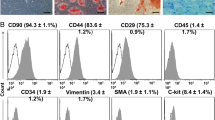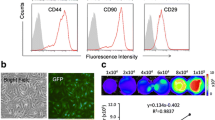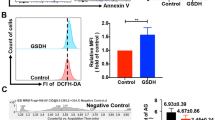Abstract
The increase of reactive oxygen species in infracted heart significantly reduces the survival of donor mesenchymal stem cells, thereby attenuating the therapeutic efficacy for myocardial infarction. In our previous study, we demonstrated that lysophosphatidic acid (LPA) protects bone marrow-derived mesenchymal stem cells (BMSCs) against hypoxia and serum deprivation-induced apoptosis. However, whether LPA protects BMSCs from H2O2-induced apoptosis was not examined. In this study, we report that H2O2 induces rat BMSC apoptosis whereas LPA pre-treatment effectively protects BMSCs from H2O2-induced apoptosis. LPA protection of BMSC from the induced apoptosis is mediated mostly through LPA3 receptor. Furthermore, we found that membrane G protein Gi2 and Gi3 are involved in LPA-elicited anti-apoptotic effects through activation of ERK1/2- and PI3 K-pathways. Additionally, H2O2 increases levels of type II of light chain 3B (LC3B II), an autophagy marker, and H2O2-induced autophagy thus protected BMSCs from apoptosis. LPA further increases the expression of LC3B II in the presence of H2O2. In contrast, autophagy flux inhibitor bafilomycin A1 has no effect on LPA’s protection of BMSC from H2O2-induced apoptosis. Taken together, our data suggest that LPA rescues H2O2-induced apoptosis mainly by interacting with Gi-coupled LPA3, resulting activation of the ERK1/2- and PI3 K/AKT-pathways and inhibition caspase-3 cleavage, and LPA protection of BMSCs against the apoptosis is independent of it induced autophagy.






Similar content being viewed by others
References
Price MJ, Chou CC, Frantzen M, Miyamoto T, Kar S, Lee S, Shah PK, Martin BJ, Lill M, Forrester JS, Chen PS, Makkar RR (2006) Intravenous mesenchymal stem cell therapy early after reperfused acute myocardial infarction improves left ventricular function and alters electrophysiologic properties. Int J Cardiol 111(2):231–239. doi:10.1016/j.ijcard.2005.07.036
Valina C, Pinkernell K, Song YH, Bai X, Sadat S, Campeau RJ, Le Jemtel TH, Alt E (2007) Intracoronary administration of autologous adipose tissue-derived stem cells improves left ventricular function, perfusion, and remodelling after acute myocardial infarction. Eur Heart J 28(21):2667–2677. doi:10.1093/eurheartj/ehm426
Geng YJ (2003) Molecular mechanisms for cardiovascular stem cell apoptosis and growth in the hearts with atherosclerotic coronary disease and ischemic heart failure. Ann NY Acad Sci 1010:687–697
Zhu W, Chen J, Cong X, Hu S, Chen X (2006) Hypoxia and serum deprivation-induced apoptosis in mesenchymal stem cells. Stem Cells 24(2):416–425. doi:10.1634/stemcells.2005-0121
Lu L, Quinn MT, Sun Y (2004) Oxidative stress in the infarcted heart: role of de novo angiotensin II production. Biochem Biophys Res Commun 325(3):943–951. doi:10.1016/j.bbrc.2004.10.106
Vanden Hoek T, Becker LB, Shao ZH, Li CQ, Schumacker PT (2000) Preconditioning in cardiomyocytes protects by attenuating oxidant stress at reperfusion. Circ Res 86(5):541–548
Wei H, Li Z, Hu S, Chen X, Cong X (2010) Apoptosis of mesenchymal stem cells induced by hydrogen peroxide concerns both endoplasmic reticulum stress and mitochondrial death pathway through regulation of caspases, p38 and JNK. J Cell Biochem 111(4):967–978. doi:10.1002/jcb.22785
Contos JJ, Chun J (2000) Genomic characterization of the lysophosphatidic acid receptor gene, lp(A2)/Edg4, and identification of a frameshift mutation in a previously characterized cDNA. Genomics 64(2):155–169. doi:10.1006/geno.2000.6122
Contos JJ, Ishii I, Chun J (2000) Lysophosphatidic acid receptors. Mol Pharmacol 58(6):1188–1196
Kaestner L, Steffen P, Nguyen DB, Wang J, Wagner-Britz L, Jung A, Wagner C, Bernhardt I (2012) Lysophosphatidic acid induced red blood cell aggregation in vitro. Bioelectrochemistry 87:89–95. doi:10.1016/j.bioelechem.2011.08.004
Tang N, Zhao Y, Feng R, Liu Y, Wang S, Wei W, Ding Q, An MS, Wen J, Li L (2013) Lysophosphatidic acid accelerates lung fibrosis by inducing differentiation of mesenchymal stem cells into myofibroblasts. J Cell Mol Med. doi:10.1111/jcmm.12178
Anliker B, Chun J (2004) Lysophospholipid G protein-coupled receptors. J Biol Chem 279(20):20555–20558. doi:10.1074/jbc.R400013200
Chen X, Yang XY, Wang ND, Ding C, Yang YJ, You ZJ, Su Q, Chen JH (2003) Serum lysophosphatidic acid concentrations measured by dot immunogold filtration assay in patients with acute myocardial infarction. Scand J Clin Lab Invest 63(7–8):497–503
Chen J, Baydoun AR, Xu R, Deng L, Liu X, Zhu W, Shi L, Cong X, Hu S, Chen X (2008) Lysophosphatidic acid protects mesenchymal stem cells against hypoxia and serum deprivation-induced apoptosis. Stem Cells 26(1):135–145. doi:10.1634/stemcells.2007-0098
Li Z, Wei H, Liu X, Hu S, Cong X, Chen X (2010) LPA rescues ER stress-associated apoptosis in hypoxia and serum deprivation-stimulated mesenchymal stem cells. J Cell Biochem 111(4):811–820. doi:10.1002/jcb.22731
Swarthout JT, Walling HW (2000) Lysophosphatidic acid: receptors, signaling and survival. Cell Mol Life Sci 57(13–14):1978–1985
Ye X, Ishii I, Kingsbury MA, Chun J (2002) Lysophosphatidic acid as a novel cell survival/apoptotic factor. Biochim Biophys Acta 1585(2–3):108–113
Guan JL, Simon AK, Prescott M, Menendez JA, Liu F, Wang F, Wang C, Wolvetang E, Vazquez-Martin A, Zhang J (2013) Autophagy in stem cells. Autophagy 9(6):830–849. doi:10.4161/auto.24132
Hamacher-Brady A, Brady NR, Gottlieb RA, Gustafsson AB (2006) Autophagy as a protective response to Bnip3-mediated apoptotic signaling in the heart. Autophagy 2(4):307–309
Terman A, Gustafsson B, Brunk UT (2007) Autophagy, organelles and ageing. J Pathol 211(2):134–143. doi:10.1002/path.2094
Takagi H, Matsui Y, Sadoshima J (2007) The role of autophagy in mediating cell survival and death during ischemia and reperfusion in the heart. Antioxid Redox Signal 9(9):1373–1381. doi:10.1089/ars.2007.1689
Baehrecke EH (2005) Autophagy: dual roles in life and death? Nat Rev Mol Cell Biol 6(6):505–510. doi:10.1038/nrm1666
Codogno P, Meijer AJ (2005) Autophagy and signaling: their role in cell survival and cell death. Cell Death Differ 12(Suppl 2):1509–1518. doi:10.1038/sj.cdd.4401751
Zhang Q, Yang YJ, Wang H, Dong QT, Wang TJ, Qian HY, Xu H (2012) Autophagy activation: a novel mechanism of atorvastatin to protect mesenchymal stem cells from hypoxia and serum deprivation via AMP-activated protein kinase/mammalian target of rapamycin pathway. Stem cell dev 21(8):1321–1332. doi:10.1089/scd.2011.0684
Resnic FS, Wainstein M, Lee MK, Behrendt D, Wainstein RV, Ohno-Machado L, Kirshenbaum JM, Rogers CD, Popma JJ, Piana R (2003) No-reflow is an independent predictor of death and myocardial infarction after percutaneous coronary intervention. Am Heart J 145(1):42–46. doi:10.1067/mhj.2003.36
Tanaka A, Kawarabayashi T, Nishibori Y, Sano T, Nishida Y, Fukuda D, Shimada K, Yoshikawa J (2002) No-reflow phenomenon and lesion morphology in patients with acute myocardial infarction. Circulation 105(18):2148–2152
Hariharan N, Zhai P, Sadoshima J (2011) Oxidative stress stimulates autophagic flux during ischemia/reperfusion. Antioxid Redox Signal 14(11):2179–2190. doi:10.1089/ars.2010.3488
Eisenberg-Lerner A, Bialik S, Simon HU, Kimchi A (2009) Life and death partners: apoptosis, autophagy and the cross-talk between them. Cell Death Differ 16(7):966–975. doi:10.1038/cdd.2009.33
Urao N, McKinney RD, Fukai T, Ushio-Fukai M (2012) NADPH oxidase 2 regulates bone marrow microenvironment following hindlimb ischemia: role in reparative mobilization of progenitor cells. Stem Cell 30(5):923–934. doi:10.1002/stem.1048
Nathan C, Ding A (2010) Snapshot: reactive oxygen intermediates (ROI). cell 140(6):951–951 e952. doi:10.1016/j.cell.2010.03.008
Naka K, Muraguchi T, Hoshii T, Hirao A (2008) Regulation of reactive oxygen species and genomic stability in hematopoietic stem cells. Antioxid Redox Signal 10(11):1883–1894. doi:10.1089/ars.2008.2114
Fang Y, Moore BJ, Bai Q, Cook KM, Herrick EJ, Nicholl MB (2013) Hydrogen peroxide enhances radiation-induced apoptosis and inhibition of melanoma cell proliferation. Anticancer Res 33(5):1799–1807
Pan H, Cheng L, Yang H, Zou W, Cheng R, Hu T (2014) Lysophosphatidic acid rescues human dental pulp cells from ischemia-induced apoptosis. J Endod 40(2):217–222. doi:10.1016/j.joen.2013.07.015
Deng W, Wang DA, Gosmanova E, Johnson LR, Tigyi G (2003) LPA protects intestinal epithelial cells from apoptosis by inhibiting the mitochondrial pathway. Am J Physiol Gastrointest Liver Physiol 284(5):G821–G829. doi:10.1152/ajpgi.00406.2002
Sun Y, Kim NH, Ji L, Kim SH, Lee J, Rhee HJ (2013) Lysophosphatidic acid activates betacatenin/T cell factor signaling, which contributes to the suppression of apoptosis in H197 cells. Mol Med Rep 8(6):1729–1733. doi:10.3892/mmr.2013.1743
Binder BY, Genetos DC, Leach JK (2014) Lysophosphatidic acid protects human mesenchymal stromal cells from differentiation-dependent vulnerability to apoptosis. Tissue Eng Part A. doi:10.1089/ten.TEA.2013.0487
Chen J, Han Y, Zhu W, Ma R, Han B, Cong X, Hu S, Chen X (2006) Specific receptor subtype mediation of LPA-induced dual effects in cardiac fibroblasts. FEBS Lett 580(19):4737–4745. doi:10.1016/j.febslet.2006.07.061
Kato K, Yoshikawa K, Tanabe E, Kitayoshi M, Fukui R, Fukushima N, Tsujiuchi T (2012) Opposite roles of LPA1 and LPA3 on cell motile and invasive activities of pancreatic cancer cells. Tumour Biol 33(5):1739–1744. doi:10.1007/s13277-012-0433-0
Chen RJ, Chen SU, Chou CH, Lin MC (2012) Lysophosphatidic acid receptor 2/3-mediated IL-8-dependent angiogenesis in cervical cancer cells. Int J Cancer J Int Du Cancer 131(4):789–802. doi:10.1002/ijc.26476
Taghavi P, Verhoeven E, Jacobs JJ, Lambooij JP, Stortelers C, Tanger E, Moolenaar WH, van Lohuizen M (2008) In vitro genetic screen identifies a cooperative role for LPA signaling and c-Myc in cell transformation. Oncogene 27(54):6806–6816. doi:10.1038/onc.2008.294
Okabe K, Hayashi M, Kato K, Okumura M, Fukui R, Honoki K, Fukushima N, Tsujiuchi T (2013) Lysophosphatidic acid receptor-3 increases tumorigenicity and aggressiveness of rat hepatoma RH7777 cells. Mol Carcinog 52(4):247–254. doi:10.1002/mc.21851
Sautin YY, Crawford JM, Svetlov SI (2001) Enhancement of survival by LPA via Erk1/Erk2 and PI 3-kinase/Akt pathways in a murine hepatocyte cell line. Am J Physiol Cell Physiol 281(6):C2010–C2019
Hara T, Nakamura K, Matsui M, Yamamoto A, Nakahara Y, Suzuki-Migishima R, Yokoyama M, Mishima K, Saito I, Okano H, Mizushima N (2006) Suppression of basal autophagy in neural cells causes neurodegenerative disease in mice. Nature 441(7095):885–889. doi:10.1038/nature04724
Matsui Y, Takagi H, Qu X, Abdellatif M, Sakoda H, Asano T, Levine B, Sadoshima J (2007) Distinct roles of autophagy in the heart during ischemia and reperfusion: roles of AMP-activated protein kinase and Beclin 1 in mediating autophagy. Circ Res 100(6):914–922. doi:10.1161/01.RES.0000261924.76669.36
Nishida K, Kyoi S, Yamaguchi O, Sadoshima J, Otsu K (2009) The role of autophagy in the heart. Cell Death Differ 16(1):31–38. doi:10.1038/cdd.2008.163
Wang ZV, Rothermel BA, Hill JA (2010) Autophagy in hypertensive heart disease. J Biol Chem 285(12):8509–8514. doi:10.1074/jbc.R109.025023
Yan L, Vatner DE, Kim SJ, Ge H, Masurekar M, Massover WH, Yang G, Matsui Y, Sadoshima J, Vatner SF (2005) Autophagy in chronically ischemic myocardium. Proc Natl Acad Sci USA 102(39):13807–13812. doi:10.1073/pnas.0506843102
Deng X, Zhang F, Rui W, Long F, Wang L, Feng Z, Chen D, Ding W (2013) PM2.5-induced oxidative stress triggers autophagy in human lung epithelial A549 cells. Toxicol In Vitro 27(6):1762–1770. doi:10.1016/j.tiv.2013.05.004
Morales CR, Pedrozo Z, Lavandero S, Hill JA (2013) Oxidative stress and autophagy in cardiovascular homeostasis. Antioxid Redox Signal. doi:10.1089/ars.2013.5359
Luo Y, Zou P, Zou J, Wang J, Zhou D, Liu L (2011) Autophagy regulates ROS-induced cellular senescence via p21 in a p38 MAPKalpha dependent manner. Exp Gerontol 46(11):860–867. doi:10.1016/j.exger.2011.07.005
Chang CL, Ho MC, Lee PH, Hsu CY, Huang WP, Lee H (2009) S1P(5) is required for sphingosine 1-phosphate-induced autophagy in human prostate cancer PC-3 cells. Am J Physiol Cell Physiol 297(2):C451–C458. doi:10.1152/ajpcell.00586.2008
Lavieu G, Scarlatti F, Sala G, Carpentier S, Levade T, Ghidoni R, Botti J, Codogno P (2006) Regulation of autophagy by sphingosine kinase 1 and its role in cell survival during nutrient starvation. J Biol Chem 281(13):8518–8527. doi:10.1074/jbc.M506182200
Daido S, Kanzawa T, Yamamoto A, Takeuchi H, Kondo Y, Kondo S (2004) Pivotal role of the cell death factor BNIP3 in ceramide-induced autophagic cell death in malignant glioma cells. Cancer Res 64(12):4286–4293. doi:10.1158/0008-5472.CAN-03-3084
Acknowledgments
The Project was supported by the National Natural Science Foundation of China (30871024 and 81170154). The authors are indebted to Dr. Shi-Yuan Cheng for an extensive edit on the manuscript.
Conflict of interest
The authors declare that they have no conflict of interest.
Author information
Authors and Affiliations
Corresponding author
Electronic supplementary material
Below is the link to the electronic supplementary material.
Rights and permissions
About this article
Cite this article
Wang, XY., Fan, XS., Cai, L. et al. Lysophosphatidic acid rescues bone mesenchymal stem cells from hydrogen peroxide-induced apoptosis. Apoptosis 20, 273–284 (2015). https://doi.org/10.1007/s10495-014-1074-0
Published:
Issue Date:
DOI: https://doi.org/10.1007/s10495-014-1074-0




